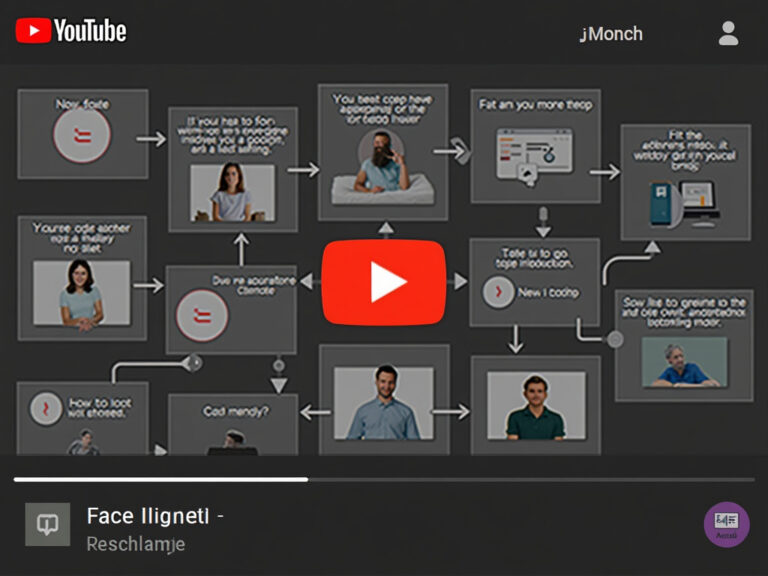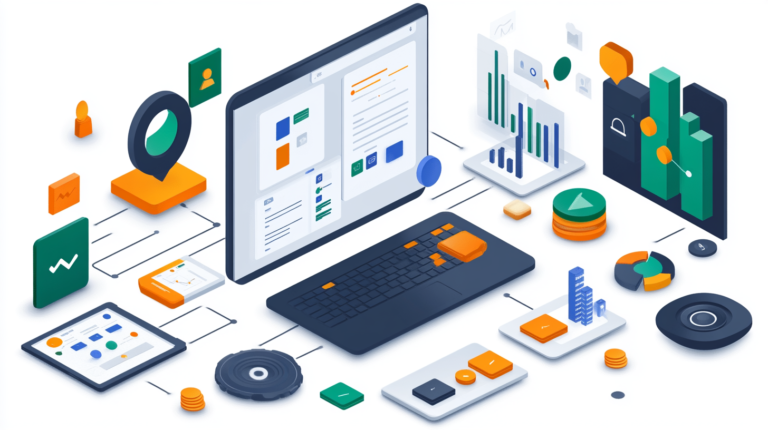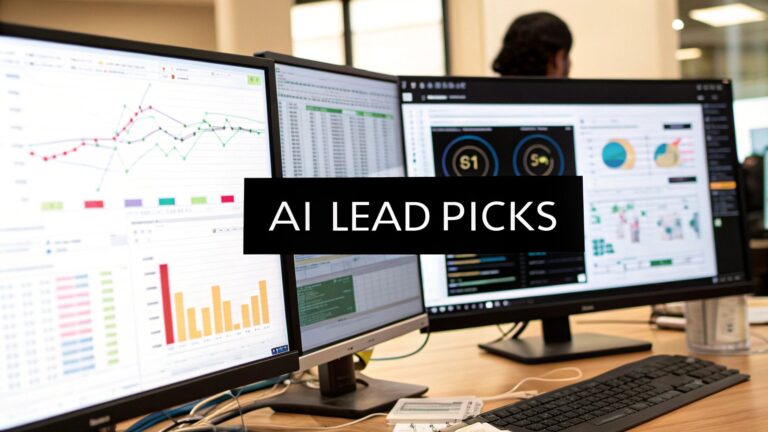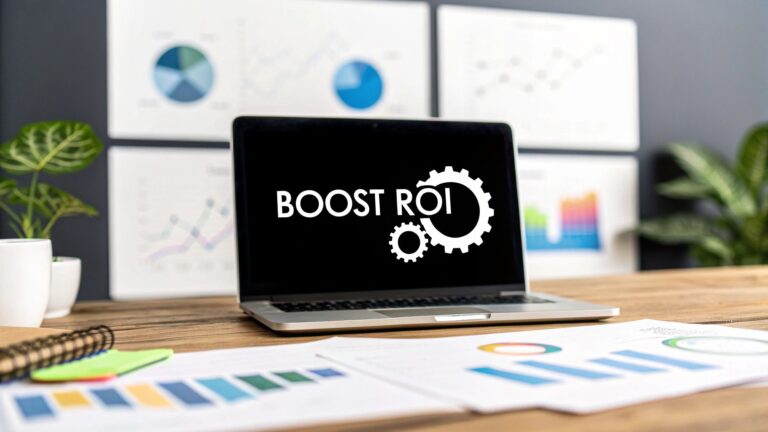8 Sales Enablement Best Practices for 2025
In the ever-evolving arena of B2B sales, staying ahead requires more than just a talented team; it demands a sophisticated, strategic approach to empowering them. Sales enablement has matured from a simple support function into the core engine of revenue generation, integrating strategy, technology, and continuous development. However, navigating the myriad of available tactics can be overwhelming, making it difficult to pinpoint which efforts will yield the highest returns.
This guide cuts through the noise to deliver a curated collection of proven sales enablement best practices that are defining success for modern revenue teams. We move beyond generic advice to provide actionable, in-depth strategies designed for immediate impact. You won't find theoretical discussions here, only a practical playbook for building a high-performing sales engine.
Inside this comprehensive roundup, you will discover how to:
- Integrate your sales and marketing technology for a seamless workflow.
- Implement dynamic content that resonates with specific buyer personas.
- Establish a culture of continuous coaching and data-driven improvement.
- Align your entire revenue operations (RevOps) function for cohesive growth.
Each practice is broken down with detailed implementation steps, real-world examples, and common pitfalls to avoid. This equips you with a clear roadmap to build a world-class sales enablement function that drives predictable growth and maximizes your return on investment. Let's dive into the strategies that separate top-performing sales organizations from the rest.
1. Unified Sales and Marketing Technology Stack
A unified sales and marketing technology stack is the bedrock of modern sales enablement best practices. It involves creating a deeply integrated ecosystem of tools where data flows seamlessly between departments. Instead of sales and marketing operating in separate digital silos, their platforms are connected to form a single, cohesive system for managing the entire customer lifecycle. This alignment ensures consistent messaging, smooth lead handoffs, and a shared understanding of customer interactions.

This approach moves beyond simple data syncing. It’s about building a single source of truth that empowers both teams. When marketing’s automation platform (like HubSpot) is fully integrated with the sales CRM (like Salesforce), a salesperson can see every marketing email a lead has opened, every webinar they attended, and every piece of content they downloaded, all within the contact record. This context is invaluable for personalizing outreach and having more relevant conversations.
Why This Is a Top Priority
A disconnected tech stack creates friction, data gaps, and misalignment. Sales may complain about lead quality without seeing the full marketing journey, while marketing may struggle to prove its ROI without visibility into which leads converted to revenue. A unified stack solves this by providing a complete, 360-degree view of the customer.
"Your CRM and your marketing automation platform are the two most important tools in your go-to-market tech stack. If they don't talk to each other, neither will your sales and marketing teams." – Sales Hacker Consultancy
This integration is especially critical for SaaS startups where the customer journey is complex and requires multiple touchpoints. Having a robust, integrated CRM is the first step in building this unified system. If you want to explore your options, you can find a comprehensive guide to the 12 best CRMs for SaaS startups here.
Actionable Implementation Tips
- Establish Data Governance First: Before connecting any systems, define clear rules for data entry, formatting, and ownership. This prevents the classic "garbage in, garbage out" problem and ensures data remains trustworthy.
- Involve End-Users in Selection: Don’t let IT or leadership choose tools in a vacuum. Involve the sales reps and marketers who will use these platforms daily to ensure the tools meet their real-world needs.
- Plan for Adoption: Technology is only as good as its adoption rate. Develop a comprehensive change management plan that includes thorough training, documentation, and champions within each team to drive usage.
- Audit and Optimize Regularly: A tech stack is not a "set it and forget it" project. Schedule quarterly audits to review integration performance, remove redundant tools, and ensure the stack is still aligned with your business goals.
2. Dynamic Content Personalization and Management
Dynamic content personalization is a systematic approach to creating, organizing, and delivering sales content that adapts in real-time. It goes beyond simply adding a prospect's name to an email. This practice leverages data to tailor entire content assets to specific buyer personas, industry verticals, deal stages, and individual needs, ensuring sales teams have the most relevant and effective materials at the right moment.

This strategy hinges on a central, intelligent content management system, often powered by AI. Instead of static PDFs, sales reps access dynamic templates where data points like industry statistics, customer logos, and specific pain points are automatically populated based on CRM data. For example, a platform like Seismic allows IBM’s sales teams to generate customized pitch decks instantly, ensuring every presentation is perfectly aligned with the prospect's profile without manual effort.
Why This Is a Top Priority
Without a dynamic content system, reps waste countless hours searching for or manually customizing materials, leading to inconsistent messaging and off-brand communications. Marketing creates a wealth of content that goes unused because it's either hard to find or not relevant enough for a specific sales conversation. A dynamic system bridges this gap, boosting both efficiency and effectiveness.
"Giving a salesperson a library of 1,000 assets is like giving them a phone book and telling them to find a lead. The goal isn't more content; it's getting the right content to the right person at the right time, automatically." – Scott Santucci, Founder of the Sales Enablement Society
This approach directly impacts a core sales enablement best practice: making sellers more productive. By surfacing the perfect case study or one-pager for a conversation, companies like Siemens and Honeywell, using platforms like Highspot and Showpad, empower their reps to focus on selling, not searching. For those looking to integrate this with their marketing efforts, you can discover more in these marketing automation best practices.
Actionable Implementation Tips
- Establish a Content Feedback Loop: Create a formal process for sales to report back on what content is resonating and what is missing. Use this feedback to guide future content creation.
- Map Content to the Buyer Journey: Audit all existing content and tag it according to sales stage, persona, industry, and pain point. This metadata is the foundation for personalization and a key sales enablement best practice.
- Implement Content Scoring: Use engagement metrics (e.g., downloads, shares, time spent viewing) to score content effectiveness. This data helps identify top-performing assets to promote and weak ones to retire.
- Sunset Outdated Content: Schedule regular (quarterly or semi-annual) content audits to archive or delete outdated, off-brand, or low-performing materials. A clean and relevant library is more valuable than a massive, cluttered one.
3. Continuous Sales Coaching and Skill Development
Effective sales enablement best practices extend far beyond initial onboarding. Continuous sales coaching and skill development involve creating a structured, ongoing framework to systematically elevate your sales team's capabilities. This moves away from one-off annual training events toward a dynamic culture of constant learning and improvement. The core idea is to embed coaching into the daily and weekly rhythm of the sales organization, using data to drive personalized development.
This approach leverages modern tools like conversation intelligence platforms (e.g., Gong.io or Chorus.ai) to analyze real sales calls, identifying specific moments for targeted coaching. Instead of relying on anecdotal feedback, managers can pinpoint exactly where a rep excels or struggles, from handling objections to asking discovery questions. This data-driven process ensures coaching is relevant, impactful, and directly tied to performance outcomes.
Why This Is a Top Priority
Without consistent coaching, even top-performing reps can stagnate, and new hires may never reach their full potential. Periodic training sessions are quickly forgotten without reinforcement, leading to wasted investment and inconsistent execution across the team. A continuous coaching model creates a feedback loop that reinforces best practices and adapts to changing market conditions.
"Coaching is not telling people what to do; it's helping them to improve their own performance. It's helping them to learn." – Sir John Whitmore, Pioneer of the GROW model
Organizations that master this see tangible benefits: shorter ramp-up times for new reps, higher quota attainment, and lower employee turnover. It transforms sales managers from simple forecasters into true performance multipliers. To further enhance individual salesperson capabilities, explore strategies for leveraging social selling indices to identify and develop top performers on platforms like LinkedIn.
Actionable Implementation Tips
- Establish a Regular Coaching Cadence: Don't leave coaching to chance. Schedule dedicated, recurring one-on-one sessions (weekly or bi-weekly) focused purely on skill development, separate from pipeline reviews.
- Use Conversation Intelligence for Data: Implement tools like Gong or Chorus to automatically record, transcribe, and analyze sales calls. Use the data to identify coachable moments and share best-practice call snippets.
- Focus on 1-2 Skills at a Time: Avoid overwhelming reps with too much feedback. Concentrate on improving one or two specific competencies per month, such as discovery questioning or objection handling, for maximum impact.
- Leverage Peer-to-Peer Coaching: Empower your top performers to act as mentors. Creating a "buddy system" or peer-led call review sessions fosters a collaborative learning environment and scales coaching efforts.
4. Data-Driven Sales Process Optimization
Data-driven sales process optimization transforms sales from an art based on intuition into a science grounded in evidence. It involves systematically using sales analytics, performance metrics, and predictive insights to continuously refine every stage of the sales funnel. Instead of guessing what works, teams use concrete data to identify bottlenecks, forecast outcomes with greater accuracy, and make strategic decisions about where to invest resources for maximum impact.
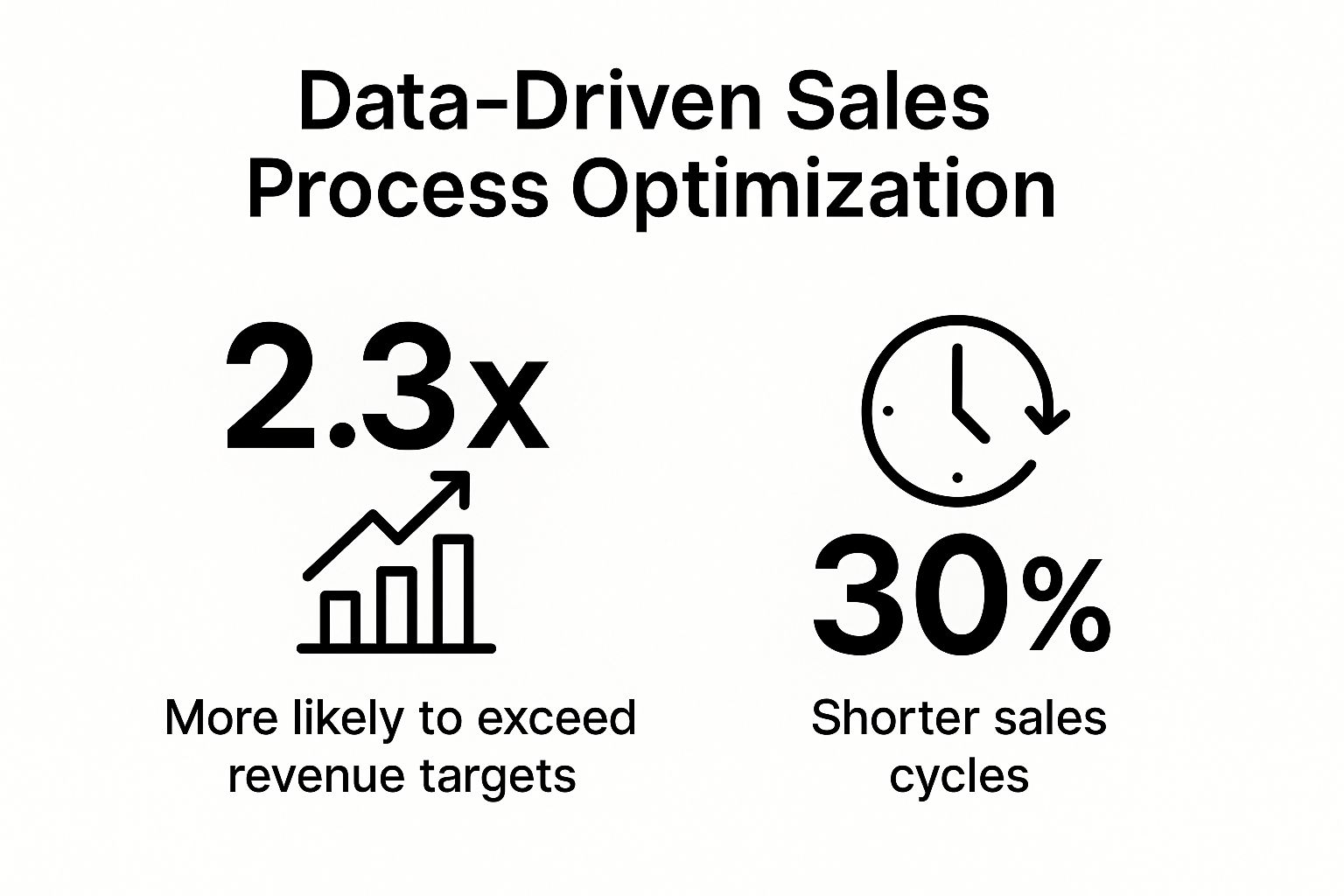
This data-centric methodology provides a clear, objective view of sales performance, moving beyond anecdotal evidence. For example, by integrating a tool like Salesforce Einstein Analytics or Microsoft Power BI with a CRM, a sales leader can see precisely which lead sources generate the highest-value deals or at which stage deals most often stall. This allows for targeted coaching and process improvements that directly address proven weaknesses rather than perceived ones.
Why This Is a Top Priority
Without data, optimizing a sales process is pure guesswork. Teams might invest heavily in training for a stage that isn't the real problem, or miss a critical drop-off point in their funnel. A data-driven approach removes this ambiguity, allowing leaders to pinpoint the exact friction points and allocate resources effectively, a core tenet of effective sales enablement best practices.
"Data is the new oil. It's valuable, but if unrefined, it cannot really be used. The same is true for sales data; without analysis and action, it's just noise." – Jill Konrath, Sales Strategist
This approach is championed by the modern Revenue Operations (RevOps) movement, which focuses on aligning all revenue-generating functions around a single source of data truth. For advanced optimization, exploring how to leveraging generative AI in sales automation can provide a significant edge in predicting customer behavior and personalizing outreach at scale.
Actionable Implementation Tips
- Start with Key Metrics: Don’t try to track everything at once. Begin with a few crucial metrics like conversion rate per stage, sales cycle length, and average deal size. Master these before expanding your analytics scope.
- Ensure Data Hygiene: The quality of your insights depends entirely on the quality of your data. Implement regular data audits and cleaning processes to ensure accuracy and consistency within your CRM.
- Train Teams on Data Interpretation: It's not enough to present a dashboard. Train your sales reps and managers on how to read the data, interpret the insights, and translate them into specific actions in their daily work. You can find more structured approaches in our guide to 10 essential business process improvement methods.
- Balance Leading and Lagging Indicators: Track lagging indicators (like closed-won revenue) to measure past success, but focus on leading indicators (like number of demos booked or proposals sent) to forecast future performance and make proactive adjustments.
5. Revenue Operations (RevOps) Alignment
Revenue Operations, or RevOps, represents a strategic evolution beyond traditional departmental silos. It involves the integration of sales, marketing, and customer success operations under a single, unified function dedicated to optimizing the entire customer lifecycle for maximum revenue growth. Instead of separate teams working with their own processes and goals, RevOps creates a cohesive engine where data, technology, and strategy are shared to drive predictable growth and enhance customer lifetime value.
This model fundamentally restructures how revenue-generating teams collaborate. It moves the focus from individual department metrics (like MQLs or close rates) to holistic business outcomes like pipeline velocity and net revenue retention. For instance, a company with a strong RevOps function, such as Snowflake, can align its marketing spend directly with sales territories that have the highest customer lifetime value, ensuring every dollar is optimized for long-term profitability, a key factor in their operational excellence.
Why This Is a Top Priority
Without a RevOps framework, friction between sales, marketing, and customer success is almost inevitable. This friction leads to data discrepancies, blame games over lead quality, and a disjointed customer experience that ultimately hurts the bottom line. RevOps breaks down these barriers by establishing a single source of truth and shared accountability across the entire customer journey, making it one of the most critical sales enablement best practices for scalable companies.
"RevOps isn't just a new buzzword; it's a fundamental shift in how businesses approach growth. It transforms the go-to-market strategy from a series of handoffs into a single, unified revenue machine." – Lorena Morales, RevOps Thought Leader
This alignment is essential for organizations aiming for hypergrowth, as demonstrated by Zoom's RevOps approach. By unifying their go-to-market operations, they could rapidly scale their processes and adapt to surging demand without the operational breakdowns that plague siloed companies.
Actionable Implementation Tips
- Start with Data and Process Alignment: Before undertaking a full organizational restructure, focus on integrating your data sources and standardizing key processes across teams. A unified view of the customer is the foundation of RevOps.
- Establish Clear Governance: Create a RevOps council with leaders from sales, marketing, and customer success. This group should define shared goals, establish clear accountability, and oversee the technology and processes that support the revenue engine.
- Create Shared Success Metrics: Move away from siloed KPIs. Implement shared metrics like customer acquisition cost (CAC), lifetime value (LTV), and pipeline velocity that all revenue-generating functions are responsible for.
- Invest in Cross-Functional Training: Ensure every team member understands the entire customer lifecycle, not just their part of it. This fosters empathy and improves collaboration, as marketers understand sales challenges and sales reps appreciate the customer success journey.
6. Buyer-Centric Sales Methodology
Adopting a buyer-centric sales methodology is a cornerstone of effective sales enablement best practices. It represents a fundamental shift away from outdated, product-focused selling. Instead of leading with features and benefits, this approach centers the entire sales process on the buyer's world: their specific challenges, goals, and decision-making journey. It’s about aligning every sales activity with how modern customers actually research, evaluate, and purchase solutions.

This methodology transforms salespeople from product pitchers into trusted advisors. By deeply understanding the buyer's context, reps can offer valuable insights, challenge assumptions, and guide prospects toward the best possible outcome, even if it’s not their own product. Methodologies like The Challenger Sale, which focuses on teaching and tailoring, or SPIN Selling, which emphasizes deep needs discovery, are prime examples of this buyer-first mindset.
Why This Is a Top Priority
In today's information-rich environment, buyers complete a significant portion of their research independently before ever speaking to a sales rep. A seller-centric process that ignores this reality is doomed to fail. A buyer-centric approach meets customers where they are, adding value at every touchpoint and building the trust necessary to close complex deals.
"Stop selling. Start helping. The best sales enablement content doesn't feel like a sales pitch; it feels like expert advice that empowers the buyer to make a confident decision." – Jeb Blount, Author of "Fanatical Prospecting"
This approach is crucial in B2B and SaaS sales where buying committees are common and the decision process is long. Focusing on the buyer's needs and facilitating their internal consensus-building process is often the only way to navigate these intricate sales cycles successfully.
Actionable Implementation Tips
- Invest in Deep Buyer Research: Go beyond basic demographics. Conduct interviews with current customers and prospects to understand their daily workflows, political pressures, and evaluation criteria.
- Map Content to the Buyer’s Journey: Create and tag sales enablement content specifically for each stage of the buyer's journey, from initial awareness to final decision-making, ensuring reps have the right asset at the right time.
- Train Reps on Consultative Questioning: Equip your sales team with advanced questioning techniques (like those in SPIN or The Challenger Sale) to uncover latent needs and reframe the customer's perspective.
- Provide Buyer Enablement Materials: Create tools that help your champion sell internally. These can include ROI calculators, business case templates, and competitive comparison guides designed for the buyer to share with their team.
7. Sales and Customer Success Handoff Excellence
A seamless handoff from the sales team to the customer success team is a critical, yet often overlooked, component of sales enablement best practices. It's the process of transferring a new customer from the acquisition phase to the post-sale relationship, ensuring all context, promises, and expectations are carried over smoothly. This structured transition prevents the customer from feeling like they've been passed off and instead creates a continuous, unified brand experience.
This process involves more than just a quick introductory email. It’s a deliberate transfer of knowledge and relationship ownership. For instance, when HubSpot closes a new customer, their integrated CRM ensures that the customer success manager (CSM) has full visibility into the sales conversations, pain points discussed, and specific goals the customer aims to achieve. This context allows the CSM to start the onboarding process from a position of knowledge, not from scratch.
Why This Is a Top Priority
A fumbled handoff is one of the fastest ways to create buyer's remorse and set the stage for churn. When customers have to repeat their needs and goals to a new contact, it erodes trust and signals a lack of internal communication. A well-executed handoff, however, reinforces the customer's decision to buy, accelerates their time-to-value, and lays the foundation for long-term loyalty and expansion revenue.
"The moment the deal is 'won' is not the end of the customer journey; it's the beginning of the customer relationship. The handoff is the first and most crucial test of that relationship." – Nick Mehta, CEO of Gainsight
This principle is especially vital in SaaS and subscription-based models, where long-term value is paramount. Platforms like Gainsight and ChurnZero are built around this philosophy, providing tools to automate and track handoff milestones, ensuring no new customer falls through the cracks.
Actionable Implementation Tips
- Standardize Handoff Documentation: Create a mandatory handoff checklist or template within your CRM. This should capture key information like the customer's primary business goals, key stakeholders, technical requirements, and any specific promises made during the sales cycle.
- Schedule a Joint Handoff Call: Arrange a warm introduction meeting where the sales representative, the new customer, and the assigned CSM are all present. This allows the salesperson to formally transfer the relationship and builds immediate rapport between the customer and their new point of contact.
- Establish Shared Success Metrics: Align both sales and customer success teams around shared metrics, such as first-year retention or initial product adoption rates. This incentivizes sales to close good-fit customers and ensures both teams are working toward the same long-term outcome.
- Create a Feedback Loop: Implement a regular process for customer success to provide feedback to the sales team. This could highlight trends in customer expectations, common points of confusion, or promises that are difficult to fulfill, helping to refine the sales process over time.
8. Mobile-First Sales Enablement
A mobile-first approach to sales enablement means designing tools, content, and processes with the smartphone or tablet as the primary interface. It acknowledges that modern sales professionals are no longer tethered to their desks. They need immediate access to information, tools, and capabilities whether they are meeting a client, traveling, or working from home. This is more than just having a mobile app; it's about optimizing the entire enablement experience for on-the-go efficiency.
This philosophy ensures that a sales rep can access the full power of their CRM, find the perfect case study, update a deal stage, or log a call note instantly from their phone. Platforms like the Salesforce Mobile App and Showpad's content management system are designed for this reality. They provide a seamless and powerful user experience that doesn't feel like a scaled-down version of the desktop software but rather a purpose-built tool for mobile productivity.
Why This Is a Top Priority
In today's fast-paced sales environment, deals can be won or lost in moments. A sales team that has to wait until they are back at a computer to access critical data or content is at a significant disadvantage. Failing to adopt a mobile-first mindset leads to data entry delays, missed opportunities, and reps who feel disconnected and ill-equipped in the field. This is a critical component of modern sales enablement best practices, directly impacting rep productivity and responsiveness.
"Your sales team doesn't stop working when they leave the office, so your sales enablement tools shouldn't either. Mobile isn't a feature; it's the new operating environment for high-performing sales professionals." – Gartner Sales Practice
For distributed or field-based teams, this isn't just a best practice; it's a necessity. It ensures that every team member has the same access to resources and capabilities, creating a level playing field and empowering them to perform at their best, regardless of location.
Actionable Implementation Tips
- Prioritize Offline Functionality: Ensure reps can access critical information like contact details, key documents, and presentation decks even without an internet connection. Syncing should happen automatically once a connection is restored.
- Design for Touch and Thumb: User interfaces must be optimized for touch screens and one-handed, thumb-centric navigation. Buttons should be large, menus intuitive, and scrolling natural.
- Optimize Content for Mobile Viewing: Convert bulky PDFs and complex spreadsheets into mobile-friendly formats. Think interactive presentations, short video clips, and easily shareable one-pagers that look great on a small screen.
- Implement Robust Mobile Security: With sensitive company and customer data being accessed remotely, use multi-factor authentication (MFA), device management policies, and data encryption to protect information.
8-Point Sales Enablement Best Practices Comparison
| Item | Implementation Complexity | Resource Requirements | Expected Outcomes | Ideal Use Cases | Key Advantages |
|---|---|---|---|---|---|
| Unified Sales and Marketing Technology Stack | High – complex integration and maintenance | Significant investment in platforms and training | Improved lead qualification, ROI measurement, reduced manual errors | Organizations needing seamless sales-marketing alignment | Eliminates data silos, real-time data sync, unified analytics |
| Dynamic Content Personalization and Management | Medium-High – requires content creation & tagging | Substantial content and AI tools, training efforts | Higher content engagement, improved deal closure rates | Teams focused on personalized buyer engagement | AI-powered recommendations, data-driven content optimization |
| Continuous Sales Coaching and Skill Development | Medium – ongoing coaching commitment | Time-intensive management involvement, training resources | Faster ramp-up, higher quota attainment, improved team skills | Sales teams emphasizing continuous learning | Data-driven skill assessment, peer coaching, personalized plans |
| Data-Driven Sales Process Optimization | High – requires quality data and analytics expertise | Investment in analytics tools and data governance | Better forecasts, shorter sales cycles, informed decisions | Organizations aiming for process refinement via data | Predictive analytics, real-time KPI monitoring, pipeline optimization |
| Revenue Operations (RevOps) Alignment | High – involves organizational change | Cross-functional coordination, training, and governance | Faster revenue growth, improved profitability | Companies seeking unified revenue management | Breaks down silos, shared KPIs, end-to-end customer insights |
| Buyer-Centric Sales Methodology | Medium – requires cultural shift and training | Investment in buyer research and enabling tools | Stronger relationships, higher win rates, shorter sales cycles | Sales adopting consultative, buyer-centered selling | Deep buyer insight, consultative selling, relationship focus |
| Sales and Customer Success Handoff Excellence | Medium – process standardization and coordination | Resource for process management and cross-team meetings | Lower churn, higher expansion revenue | Businesses aiming for smooth sales-to-success transitions | Improved onboarding, shared success metrics, customer retention |
| Mobile-First Sales Enablement | Medium – mobile app development and security measures | Development and training for mobile tools | Increased productivity, CRM adoption, higher engagement | Teams working remotely or on-the-go | Mobile-optimized tools, offline access, enhanced responsiveness |
From Strategy to Execution: Activating Your Enablement Plan
Navigating the landscape of modern sales requires more than just a talented team; it demands a sophisticated, interconnected ecosystem designed to empower every seller at every stage of the buyer's journey. Throughout this guide, we've explored the pillars of a world-class enablement program. We've seen how a unified tech stack eliminates friction, how dynamic content makes every interaction relevant, and how continuous coaching transforms potential into performance. These are not isolated tactics but interwoven components of a holistic strategy.
The journey from understanding these concepts to seeing them drive revenue begins with a shift in mindset. True sales enablement is not a project with a defined end date. It's a cultural commitment to continuous improvement, a perpetual motion machine fueled by data, feedback, and a relentless focus on the buyer. Embracing these sales enablement best practices is about building an agile, responsive, and intelligent sales organization that can adapt to changing market conditions and evolving customer expectations.
Synthesizing the Core Principles
The eight practices we've detailed represent a comprehensive blueprint for modern sales success. Let's distill them into their core, actionable takeaways:
- Technology as the Foundation: Your CRM, content management system, and communication tools must work in harmony. The goal is a single source of truth that automates administrative tasks and surfaces critical insights, freeing sellers to do what they do best: sell.
- Content as Conversation: Move away from static, one-size-fits-all collateral. Your content strategy should be dynamic, personalized, and easily accessible, providing sellers with the perfect asset for any conversation, right when they need it.
- People as the Engine: Technology and content are merely tools. The real driver of growth is your people. A robust coaching program, rooted in real-world performance data and focused on skill development, is the single most powerful investment you can make in your team's success.
- Process as the Guide Rails: A data-driven sales process, aligned with a buyer-centric methodology and integrated across revenue operations (RevOps), provides the structure needed for scalable, predictable growth. This ensures everyone is speaking the same language and working towards the same goals.
Your First Steps Toward Enablement Mastery
Feeling overwhelmed by the scope of these initiatives is natural. The key is to avoid trying to boil the ocean. Instead, adopt a phased, iterative approach focused on generating early wins and building momentum.
- Conduct an Honest Audit: Where are the biggest points of friction in your current sales process? Start by surveying your sales team. Is it finding the right content? Is it wrestling with clunky software? Is the handoff from marketing creating unqualified leads? Pinpoint the most significant pain point.
- Prioritize for Impact: Choose one or two of the best practices that directly address your most pressing challenge. If your team is wasting hours on manual data entry, start with tech stack unification and automation. If your win rates are lagging, focus on implementing a structured coaching program or refining your sales methodology.
- Define Success and Measure Everything: For your chosen initiative, establish clear, quantifiable key performance indicators (KPIs). For a content management project, this might be a reduction in the time sellers spend searching for content. For a coaching program, it could be an increase in the average deal size or a shorter sales cycle.
- Iterate and Expand: Once you've demonstrated value in one area, use that success to gain buy-in for the next phase. A successful tech integration can pave the way for more sophisticated data analysis. A successful coaching pilot can justify a full-scale program.
By implementing these sales enablement best practices, you are doing more than just helping your team hit its quota. You are building a resilient, customer-obsessed revenue engine. You are creating a professional environment where top talent can thrive and grow. This strategic alignment is the definitive characteristic of companies that don't just compete but dominate their markets, fostering deeper customer relationships and unlocking sustainable, long-term growth.
Ready to move from strategy to execution? At MakeAutomation, we specialize in implementing the foundational automation and integration frameworks that power elite sales enablement. We help B2B and SaaS companies build the streamlined, scalable systems discussed here to eliminate friction and empower their teams. Visit MakeAutomation to learn how we can build your 7-figure revenue engine.



